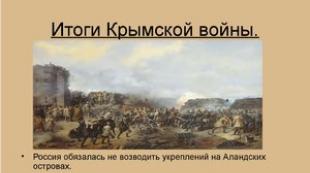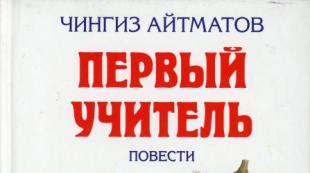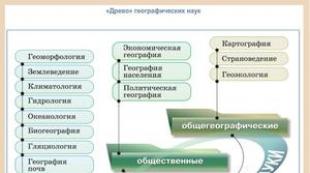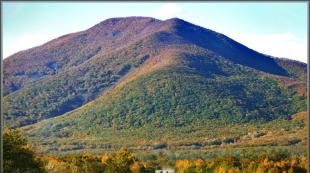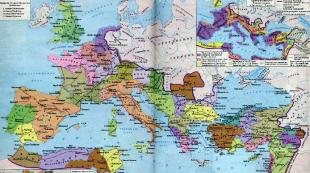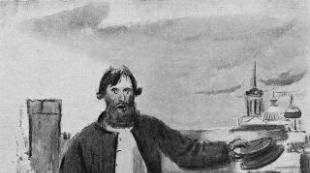Alexander Pushkin - Cloud: Verse. A.S. Pushkin "Cloud". The last cloud of the scattered storm! You alone are the Poet's house, the last scattered cloud
A.S. Pushkin "Cloud". The last cloud of the scattered storm! Alone you rush along clear azure , One you bring a dull shadow, One you sadden a jubilant day. You recently wrapped around the sky, And lightning wrapped menacingly around you, And you uttered a mysterious thunder, And the greedy earth watered with rain. Enough, hide! The time has passed, the Earth has refreshed, and the storm swept by, And the wind, caressing the leaves of the trees, Drives you from the reassured heavens. Olympiad task Conduct a linguistic analysis of the text. Give detailed answers to the following questions: 1. What feeling is imbued with the poem? How does the construction of a poem help determine the mood of a lyric hero? 2. Find in the poem: - stylistic figures and tropes; - categorical difference and similarity of the tenses of the verb; - individual author's combination of words. 3. Explain what is the role of the named artistic and linguistic means in the text. 4. Give a linguistic commentary on the words: "azure, greedy, passed, hide, wood." What "meanings" does the use of these words bring to the poem? 5. Is the image of a cloud in this poem traditional for the poetic language of the first half of the 19th century? Explain your point of view. Pushkin's poem "The Cloud" is imbued with the freshness of a summer day after a thunderstorm, permeated with sunlight, only a cloud, which, for some reason, lingered in the sky, "casts a dull shadow." The poem "impatient": both the poet and nature, as if waiting for the sky to become clear, the cloud will disappear behind the horizon. The construction of the poem is interesting. In the first quatrain, the poet as if reproaches the cloud for the fact that it has not disappeared yet, catching up with melancholy and memories of the last shower. In the second quatrain, the author recalls the past thunderstorm, when the earth greedily swallowed life-giving moisture, when lightning flashed dazzlingly, thunder sounded ... When this cloud was in its prime. In the last four lines, the poet turns to the cloud, says that its time has passed and urges it to get out of sight as soon as possible. It is no coincidence that the poem is constructed this way. I quatrain tells us about a cloud, the main character, this is a kind of "introductory" quatrain. Here the author regrets that the cloud still darkens the "clear azure" of the sky. I quatrain - the apotheosis, the culmination of the poem. Memories inspire the poet, he paints her picture for us with bright juicy colors. We can say that these four lines are the most aggressive in the entire poem. The last, III quatrain is filled with pacification. The author no longer threatens anyone, but only persuades the cloud to hide. This is the appropriate ending to the poem. In the poem, we see a variety of stylistic figures and tropes. Despite the fact that the theme and idea of the poem is the same, each quatrain has its own style. I quatrain - a little dull; to feel his mood help stylistic images created by the poet: "" a dull shadow ", for example, or the whole line" You alone sadden a jubilant day. " On the other hand, this quatrain seems to prepare us for the next, more "militant" one. Here one can feel the poet's annoyance at the recalcitrant cloud. This makes us understand both the appeal to the cloud, and the threefold repetition of "one you". Style II quatrain - aggressive "fighting". This is evidenced by some phrases: "it wrapped menacingly around you", "uttered a mysterious thunder", "greedy land." Help us to better perceive the mood of the quatrain and repetitive "growling" consonants in the words "around", "menacing", "thunder". It should be noted that they are absent in the last line, which is the main transition to the III quatrain. His style and key word is appeasement. The author does not demand, but asks for the cloud: "Enough." The stylistic images are also calm here. We seem to imagine "leaves of wood" and "tranquil skies". Here are also used characteristic words with phrases: "passed", "refreshed", "caressing the leaves of the wood". All this helps us to better feel the freshness and style of the final quatrain. In the poem, one can note the categorical difference and similarity of the verb of the tenses of the verb. The present tense of the verb is used in both I and III quatrains. It should be noted that they are similar in style: the poet sometimes demands, then asks the cloud not to darken a sunny day. In Quatrain II, the author used the past tense of the verb, recalling the past thunderstorm. With this, he kind of emphasized the difference between calm I, III and “belligerent” II quatrains. In lyric miniature A.S. Pushkin's "Cloud", we can note the individual author's combination of words. The poet used here many vivid epithets, besides him, which are not characteristic of anyone else. Among them, the following combinations stand out: "scattered storm", "clear azure", "dull shadow", "jubilant day". Note: not a joyful, not cheerful, but a "jubilant" (!) Day. “Threateningly wrapped around”, “greedy earth”, “mysterious thunder”, “tranquil heavens”. These artistic means play a huge role: they help us understand and feel the mood of the poem. They make it richer and brighter, If it weren't for them, there would be a poem? Let's do a little experiment: we will only remove epithets from the first quatrain. What happens? The last cloud ... storm! One you rush across the sky, One you direct ... a shadow, One you sadden ... day. Well, is this a poem? Of course not. We must not forget that we have removed only epithets, and what will happen if we leave the poem without metaphors, inversions, comparisons, hyperboles ?! Now, I think, it is clear that without artistic and linguistic means in a poem (and in prose!) It is absolutely impossible! 4. Azure - the word means bright, clear blue. In a poem, this is a very important word. Compare: "by clear azure" and "by clear blue". Greedy means "greedy", this word is no less important in the poem. Passed - that is, passed, passed. This word is outdated, now it is not used. Hide - hide, succeed, this word is also outdated. Wood - trees, this word is not used in modern Russian. These words, it seems to me, set the reader in a solemn mood, serve to more fully reveal the meaning of the poem. 5. I think so, it is. It was at the beginning of the 19th century. the heyday of romanticism falls. It was marked by enthusiasm, impetuosity. The poem, as they say, matches. It is imbued with delight from a clear "jubilant" day, from a "clear azure", the poet is in admiration for nature. And he describes the recent thunderstorm brightly, colorfully, which is no less characteristic of romanticism. The poem by A.S. Pushkin's "Cloud" is imbued with a sense of hope for the best. We see the victory of good over evil. The mood of the lyric hero changes in the course of the poem. At first it is gloomy, and dull, and sad, but as after rain and thunder, nature is “reborn”: “the earth is refreshed” and the wind “caresses the leaves of the trees”, so the poet's soul becomes clear and light. The first line of the poem "The last cloud of the scattered storm!" the lyrical hero-author shows that the whole main storm is already behind, thunder, lightning - everything has already passed. This means that the composition of the poem seems to lack the peak moment - the culmination. The last cloud is just a remnant of the raging elements. So we can call the whole poem "Cloud" the denouement of some action: the hero is already calming down, his mood improves, his soul becomes light and free, and nature is gradually recovering from the storm. In the poem by A.S. Pushkin's "Cloud" we see the artistic image of the cloud. It is a collection of all the negative emotions of the author, but at the same time, nature needs a cloud, grass and trees need rain. The cloud is the personification of something fickle: here it “utters a mysterious thunder”, and now it rushes across the sky, driven by the wind. So, a cloud is a symbol of impermanence, sad and dismal, but very necessary for nature. There are many interesting tropes in the poem. For example, the epithets "scattered storm", "mysterious thunder", "greedy land", "jubilant day", etc. In the first stanza of the poem there is anaphora - one-man command: One you rush along the clear azure, One you throws a dull shadow, One you sad jubilant day. In the second stanza, we can notice the author's intentional repetition of vowel sounds - assonance. In this case, the repetition of the vowel sound "O" - creates a sound image of the storm. We seem to hear thunder, we are scared, and the sounds of fear and delight - the interjection of "O" and "A" involuntarily break out. You recently lightened the sky around, And the lightning wrapped menacingly around you, And you uttered a mysterious thunder. In describing a recently raging storm, the author uses assonance. The author seems to be participating in the action of his poem. In the third stanza, you can see the individual author's combination of words: "Enough, hide!" So the author seemed to imagine himself the lord of storms, ordering the cloud to rush away as soon as possible. The poem also contains a linguistic means - the categorical difference between the tenses of the verbs. The author describes two actions in the poem: the past storm and the remaining cloud. Consequently, the storm that reigned a few minutes ago has already ended, which means that the author uses the past tense for verbs associated with the elements (she wrapped, wrapped, published, went). But now a new, quiet and calm time has come, when the cloud is left alone and carries out its last actions (rushing, directing, saddening). The poem "Cloud" refers to the last stage in the work of A.S. Pushkin. The poem depicts a very dynamic landscape painting. Movement, development is given through the antithesis, which is conveyed by the present and past tense of the verbs. The poem consists of three stanzas. In the first stanza, the image of the lyrical hero is imbued with a sense of loneliness. The repetition of the word "one" and the anaphora of stylistic figures ("dull shadow" - "jubilant day") once again emphasize the feelings of the lyrical hero. In the second stanza, the lyrical hero is immersed in thoughts about the past. This is conveyed by the use of past tense verbs ("fit", "published", "wrapped", "went"). To give eccentricity, uplifting mood, the author uses the lexical anaphora (and ..., and ...) and the frequent repetition of the word "you". We can also observe exclamations in stanza 1 and 3. In the third stanza, the lyric hero addresses the cloud (“Enough, hide!) This request seems illogical in light of the events that have taken place. But further this is explained by the use of the past tense of verbs ("passed", "rushed"). The vocabulary of the poem is very interesting. The word "azure" is used in the sense of a bright, blue sky. "Greedy" - thirsty, asking for moisture. In combination with a noun, an impersonation is obtained. The words "passed", "hide", "wood" are archaisms. They are used to keep the rhythm and rhyme of a poem. The poem was written in amphibrachium with four feet using paired rhymes (masculine and feminine). The images in the poem are not only symbolic, but also allegorical. Perhaps the storm means some kind of stormy feeling that left a mark on the poet's soul. Or is it a kind of appeal to the king. Alexander Sergeevich reminds him of the Decembrist uprising. He hopes for the release of the exiled Decembrists. If so, then the image of a cloud in this poem is unconventional for the poetic language of the first half of the 19th century. The cloud signified danger ("The Tale of Igor's Regiment", "Ruslan and Lyudmila"). I believe that A.S. Pushkin found a new sound and expanded the meaning of the word "cloud". Conduct a linguistic analysis of the poem by A.A. Feta "Learn from them - from the oak, from the birch." Learn from them - from the oak, from the birch. Winter is everywhere. It's a cruel time! In vain tears froze on them, And the bark cracked, shrinking. All angry blizzard and with every minute Heart tears the last leaves, And the heart is seized by a fierce cold; They stand silent; be silent and you! But trust the spring. Her genius will rush, Again with warmth and life breathing. For clear days, for new revelations, the grieving soul will be sick. Poem by A.A. Feta "Learn from them - from an oak, from a birch" was written in the early 80s. Already in the 50s, the romantic poetics of Fet was formed, in which the poet reflects on the connection between man and nature. He creates whole cycles: "Spring", "Summer", "Autumn", "Evenings and Nights", "Sea", in which, through pictures of nature, the reader and the lyrical hero comprehend the truth about man. In this sense, the poem "Learn from them - from an oak, from a birch" is very characteristic. A discreet picture of Russian nature is reflected in poetry in a peculiar way. The poet notices its elusive transitional states and how an artist "paints", finding new shades and colors. The term "poetry of the Impressionists", applied to the lyrics of Fet, most accurately reflects the search for poets-thinkers, poets-artists. Even Fet's contemporaries, especially Saltykov-Shchedrin, emphasized the complete fusion of man with nature in his lyrics. In the voice of Fet, the voice of a living creature is heard, such as grass, trees, animals. The poet can "be silent" with their language, plunging into statistical contemplation. And after the poet, the reader is faced with harsh pictures of disharmony in nature, and in Fet's way, in the human soul. They evoke a number of associations: trouble, disorder, anxiety, anxiety. This is facilitated by metaphorical images: “useless tears froze”, “a fierce coldness grabs the heart”; negatively emotionally tinged epithets: "fierce cold", "cruel time", "grieving soul", inversion "in vain tears froze on them" The culmination of bad weather in nature is associated with emotional sensations. In the first and third stanzas, mainly simple and simple complicated sentences are used (complication with adverbial phrases, homogeneous definitions). The second stanza has a different syntactic structure: complex non-union proposal... Short, informatively rich sentences add dynamics to the poem. The second stanza stops the dynamics of the poem, slows it down, in the third stanza the dynamics is restored. Incentive sentences set the tone for the entire poem, the forms of verbs in the imperative mood give elements of didactic instruction, the outdated forms of the words "shrinking", "life" give solemnity to speech. At first, the poem is imbued with pessimistic sentiments. The whipping up of tragic motives is especially noticeable in the second stanza, where the author allowed himself to use lexical repetitions: “heart tears” - “grabs the heart”, “they are silent; be silent and you. " Such a technique reinforces the expectation of a denouement, which is why the third stanza begins with the adversarial conjunction “but” (“But believe in spring”). The alliance "but" invades the last stanza, contradicts the world of disorder and discord. carries a light image of beauty, harmony. Now the figurative system serves to create feelings of a different kind - the belief in the triumph of goodness, beauty, harmony. Perhaps Fet saw in nature what he lacked so much in life, in the sphere of human relations (many years were spent on restoring the title of nobility, tragic love for Maria Lazic). I believe that this poem is a vivid example of the fact that all his life Fet did not stop rereading the great and sublime book of nature, remaining a faithful and attentive student of it. And following the poet, the reader should also cognize nature, because in it is the key to all the secrets of human existence. Nature - best teacher and mentor man. A metaphor is unfolded before us. The philosophical and psychological subtext of the poem is obvious. Oak is a symbol of stamina, strength, strength. Birch is a symbol of vitality, resistance to adversity, flexibility, vitality. The basic words are winter - adversity, spring - full-blooded free life. The speech in the poem, therefore, is about the fact that a person must courageously endure the blows of fate and believe in the inevitability of change. The poem breathes movement, but there is not a single word directly expressing movement in it. To a greater extent, the poem is unique in that two very different series of events converge in one aesthetic reality. The ending is the most emotionally strong, it contains all the power of the poem. The artistic world is created by a variety of rhythms, sounds and special syntax, i.e. melodious style. In the first stanza, nominative incentive sentences are used, since Fet strove to express the entire complexity of the mental life of man and nature. The second stanza closes the culmination in the soul and in nature. In the third stanza, the opposing union changes the mood of the lyrical hero, and behind the pictures of a cruel winter, one can feel the revival of hope. The poem is written in three-syllable amphibrach with a cross w / m rhyme. The poet liberated the word and increased the load on it - grammatical, emotional, semantic. At the same time, the semantic unit of a poetic text is not a single word or even individual words and expressions, but the entire near and far context. The poem itself is a vivid lyrical experience, an instant lyrical flash. Also, the poem uses outdated forms: "living", "shrinking". The author's presence is felt: "tears froze in vain", "a grieving soul." Fet is perceived by the symbolist poet, who, like a sage, turns tragedy, pain, compassion into beauty. It is in the ineradicable ability to pass everything through the heart that his creativity is perceived. " Expressively read the poem by I. Severyanin "Two-fold silence." Conduct a linguistic analysis of the poem. Quiet double The moon is high. The frosts are high. Distant carts creak. And it seems that we can hear the Arkhangelsk silence. It is audible, it is visible: In it are the sobs of the cranberry bog. In it crunches of snowy canvas, In it of quiet wings, the whiteness of Arkhangelsk silence. Igor Severyanin chose an unusual title for the poem - "Quiet is two-fold". On the one hand, the reader can hear it, the silence is described in such “detail”, it contains a lot of everything, from “cranberry bog sobs” to “crunches of snow canvas”. It would seem, well, what can be special in silence? But only at first glance it may seem that the silence is lifeless and dull, it is not in vain that Igor Severyanin belonged to the poets of the "Silver Age", because he was able to make the reader not only hear the silence, but also "see", feel it ... The moon is high. The frosts are high. Anaphora "high" is rather unusual for the first lines. I would like to raise my head and see this moon, feel such frost. The poem was written with iambic tetrameter using a ring composition. This helps the author to reveal the idea: to describe the silence in such a way that every sound is distinguishable in it. Alliteration of the sounds "w", "z", "x" creates the effect of crunching, rustling, sobbing. If you read the poem out loud, you can really hear it. An incomplete sentence with missing predicates also helps to create an image of silence. The poet repeats the word "audible" to once again draw the attention of readers: so quietly that silence can be heard. and this all-consuming silence allows you to hear the "distant creak of carts." Dash sums up everything that "is in the" Arkhangelskaya Tishina ". It is interesting to compare snow with "snow canvas", that is, the snow is white, like the sail of a ship in the sea. It is complex, it is visible: In it are the sobs of the cranberry bog. The colon proves that she is really visible from what is happening around. The epithet "quiet" emphasizes that even the wings try not to disturb this peace. It is difficult to talk about silence, if most often it is associated with death, eternal peace. But the silence "overheard" by the poet is different - this is the unhurried flow of life, sleep and awakening, the absence of an anxious, intense stream of everyday affairs. The techniques and figures used complement the image of this complex phenomenon called silence. The poem by I. Severyanin “Quietness is twofold, built on a system of interconnected overlapping images. It is not so much individual words or phrases that are important, but the associations that they generate in the reader. We seem to plunge into another world, find ourselves in the snow-covered Russian outback, where we peer and listen attentively to the silence, "two-fold". "Speaking" is the very title of the poem. What do you mean "quiet double"? And in general, how can you hear silence, because silence is the absence of any sounds ?! But in Severyanin, this very silence is made up of "sobs of a cranberry bog", from the creak of carts and "crunch of snow canvas", i.e. more simply, the crunch of snow underfoot. Severyanin's silence is "visible"; it is not silence and not just a combination of sounds, it is a special feeling, a special atmosphere hovering over the Arkhangelsk expanses. Speakers "are the epithets that are then used to describe the picture he presents:" high moon "- this is because the moon in the north seems distant, located high-high in the sky; "High frosts" means severe frosts; "Sobs of the cranberry bog" - this phrase tells a lot. Firstly, that in summer cranberries grow in the bogs in the Arkhangelsk outback, that the bog makes strange sounds, similar to sobbing, evoking melancholy. "Quiet wings whiteness" - this is probably said about the angels looking from the ancient Archangelic icons. From all this, "double silence" is formed, "Arkhangelsk silence", Arkhangelsk, incomparable spirit. The poem is written at such a pace, using such methods of constructing a phrase and a sentence, that the reader has a feeling of a leisurely flow of time, peace. Short, complete sentences give certainty to everything the poet said. A technique is used when several lines begin with the same phrase (one word), which emphasizes the features of the described object (or phenomenon), and, in addition, gives the poem some resemblance to a simple, soulful song. " Analyze the poem based on the questions. A wonderful city will sometimes merge From flying clouds; But only the wind will touch him, He will disappear without a trace; Thus, the instant creatures of the Poetic Dream Disappear from the breath of Outside vanity. E. Baratynsky 1. What is this poem about (determine the topic), 2 b. his main idea (formulate yourself or find in the lines of the poem). 2 b. 2. What semantic parts can this poem be divided into? 2 b. On what technique is it built? 2 b. 3. What "extraneous vanity" does the last line refer to? 2 b. 4. What, according to the author, is the death of poetry? 2 b. 5. Try to define in one word what “disappears”. 1 b. 6. What means of expression help the author to convey his thought? From 1 b. 7. Determine the verse size. 2 b.
The poem "Cloud" refers to the landscape and philosophical lyrics of Alexander Sergeevich Pushkin, and although at this time the poet had already begun to move away from romanticism, this work is completely sustained in this direction. It is necessary to read the verse "Cloud" by Alexander Sergeevich Pushkin carefully, because this work is not accidental. It was written on April 13, 1835. The next day, the poet was supposed to get an appointment with the head of the Third Section, A.K. Benckendorff, to whom he applied to publish his own newspaper. The poet hoped that the storm clouds over his head would finally dissipate and life would return to normal. The image of the cloud is classic for romantic fiction. It is a symbol of sadness, anxiety, danger. The poet, as it were, describes everything that happens in his life, reveals his fears and hopes to the reader. In the first part of the poem, a cloud is just approaching, bringing fear and despondency to the poet, in the second the storm has already broken out and the long-awaited rain has poured on the earth, but in the third the cloud has gone, fears and anxieties have dissipated. The poet, with the help of symbols, images and allegories, tries to convey to the reader the idea that everyday storms are a temporary, passing phenomenon.
The poem also carries a different semantic load. Pushkin, using the antithesis, draws the storm and the calm after it with watercolor precision, as if saying that the time of his glory has passed, that it is necessary to leave the “poetic stage”, to make way for young talents. At this time, the poet was really going through a certain creative crisis, he and his works were no longer so admired by the readers, and critics directly said that "Pushkin is not the same." Some researchers believe that "Cloud" is a poem dedicated to the decade that has passed since the Decembrist uprising. The poet, in his work, seems to say that the time of storms, when his poems were really needed, is over. In this poem, Pushkin uses many different epithets that enhance the "picturesque" of the story, convey the mood of the original house and the ensuing peace, personifications revive nature and the main "hero" of the story - a cloud. The poet resorts to the method of alternating female and male rhymes, which is atypical for landscape works. The rhythm of the piece is very even, calming, measured. Learning this work by heart is easy. This work was recognized as the best landscape poem by Pushkin. The richness and beauty of artistic images impresses readers today. It is usually disassembled in literature lessons in grade 9.
The text of Pushkin's poem "Cloud" can be downloaded from our website or read completely online.
CLOUD
The last cloud of the scattered storm!
Alone you rush along the clear azure,
You alone cast a dull shadow
You alone sadden a joyous day.
You recently wrapped around the sky,
And lightning wrapped menacingly around you;
And you made a mysterious thunder
And the greedy land watered with rain.
Enough, hide! The time has passed
The ground refreshed and the storm swept by
And the wind, caressing the leaves of the wood,
Heaven drives you from the reassured.
(A.S. Pushkin, 1835)
Warm up:
Q8- What is the name of the method of “humanizing” the phenomena of the natural world, to which A.S. Pushkin resorts, drawing the image of “the last cloud of a scattered storm”?
B9- Name an artistic technique based on the opposition of dissimilar phenomena ("dull shadow" - "jubilant day").
B10- Name an artistic means, which is a figurative definition, which is repeatedly used in a poem and enhances the emotional sound of images ("clear azure", "greedy earth", "dull shadow", etc.)
Q11- What is the term for a stylistic device, which consists in the same beginning of each line (“You alone are rushing along the clear azure, // You are alone in casting a dull shadow, // You are alone in a grieving day ...”)?
B12- Determine the size, which is written the poem "Cloud".
Answers:
B8 - impersonation
B9- antithesis
B10- epithet
B11- anaphora
B12 - amphibrachium
Ideological level (the first cliché works best for this poem)
Characteristics of images
What is the philosophical meaning of Alexander Pushkin's poem "The Cloud"?
^ An example of an essay on this issue for 4 points (with partial use of clichés):
A.S. Pushkin put a special philosophical meaning into this work. The poem "Cloud" can be viewed as a reflection on the past and the future. The image of the cloud personifies the last "relic of the past". This is revealed through such pictorial and expressive means as the epithet: "dull shadow", "greedy land", "mysterious thunder"; personification: "you alone (the cloud) cast a dull shadow." The author also uses the antithesis ("dull shadow" - "jubilant day"), with the aim of opposing the past and the future.
MONUMENT
I have erected a wonderful, eternal monument to myself,
It is harder than metals and taller than the pyramids;
Neither a whirlwind nor thunder will break the fleeting one,
And the flight of time will not crush him.
So! - all of me will not die, but part of me is large,
Having escaped from decay, after death he will live,
And my glory will grow without fading,
Until the Slavs, the universe will honor the race.
The rumor will pass about me from White waters to Black waters,
Where the Volga, Don, Neva, the Ural pours from Riphea;
Everyone will remember that in innumerable nations,
How from obscurity I became known to those,
That the first one I dared in a funny Russian syllable
To proclaim the virtues of Felitsa,
Conversation of God in the Simplicity of the Heart
And tell the truth to the kings with a smile.
O muse! take pride in the merit of the just,
And whoever despises you, despise those yourself;
With a relaxed, unhurried hand
Crown your forehead with the dawn of immortality.
(G.R. Derzhavin, 1795)
Warm up:
Q8- What genre does the poem by G.R.Derzhavin "Monument" belong to?
B9-Indicate the name of the literary movement that arose in Russia in the 2nd quarter of the 18th century and was embodied in the work of G.R. Derzhavin.
В10- Name the image of ancient mythology, which is in the poem "Monument" by G.R.Derzhavin, a symbol of poetic inspiration.
В11- What kind of trail, based on the figurative meaning of the word by similarity, does Derzhavin use to create high artistic imagery in the phrases “flight of time”, “dawn of immortality”?
В12- Determine the size of the poem by G.R.Derzhavin "Monument".
Answers:
В9- classicism
B11- metaphor
Questions for analyzing a poem with a cliché, helping to form the answer in tasks C3, C4. We answer the question and make 1-2 sentences. If there is a problem in the wording, we use clichés (if there are no problems, then we respond accordingly in our own words). I will put pluses on correctly composed sentences. How to answer the questions, let's start writing an essay.
Determine the theme of the poem (philosophical, love, landscape, poetry and poetry, etc.)
Ideological level
Interpretation of the name
Visual and expressive means. Trails. (indicating the trope at the place of the ellipsis, we use quotations, for example: metaphor - "the dawn of immortality")
Visual and expressive means. Stylistic figures (repetitions, rhetorical question, exclamation, antithesis, etc.). Also, indicating the stylistic figure, we use quotation.
Visual and expressive means. Poetic phonetics (alliteration, assonance, anaphora, epiphora, etc.). Lexical means of expressiveness (synonyms, antonyms, neologisms, archaisms, etc.). We use quotation.
Poems by Russian poets, which are similar in theme to the "Monument" by G.R.Derzhavin (We name the authors and titles of the poems)
What unites the poems you named with the work "Monument" by GR Derzhavin? What are their differences? (we argue our point of view with quotes)
Task C3. Let me remind you that the volume of the essay is 5-10 sentences. The use of terms is obligatory, at least 5 (the words "work", "lyrical hero", "image", "tropes", etc. are considered as terms). We try not to allow speech errors... If it's hard to formulate your thought, we use, if appropriate, some of the sentences we have compiled earlier, and the clichés.
C3- What, according to G.R. Derzhavin, is the true reward for poetic talent?
^
С3- In the poem "Monument", GR Derzhavin reflects on the theme of poet and poetry. The author believes that the highest reward for a poetic talent is memory, "immortality" of the poet's creations. The very name "Monument" embodies something eternal and sublime. The poet's confidence in his immortality and in the immortality of the human word is revealed in the poem through such pictorial and expressive means as the metaphor: "flight of time", "dawn of immortality." To show his merits, the author uses hyperbole: "I have erected a wonderful, eternal monument to myself, it is harder than metals and higher than the pyramids."
С4- What Russian poets developed the theme of poet and poetry in their work, and how can the poem by G.R. Derzhavin be related to them?
^ An example of an essay on this topic for 4 points (with partial use of clichés):
C4- In their lyrics, A.S. Pushkin and M.Yu. Lermontov addressed the theme of the poet and poetry, just like G.R. Derzhavin. The authors, through their poems, tried to answer the question: "What is the true purpose of the poet?" The poem "Monument" by A.S. Pushkin can be correlated with the "Monument" by G.R.Derzhavin. From the first stanza, these works are similar in mood and thoughts of the author: “I have erected a wonderful, eternal monument to myself” (G.R.Derzhavin), “I have erected a monument to myself not made by hands” (A.S. Pushkin). Also, these poems have common features with "The Death of a Poet" by M.Yu. Lermontov. They all speak about the purpose of the poet and the immortality of his lyrics. This is reflected in the following lines: “Wondrous genius, like a torch, died away” (M.Yu. Lermontov), “Crown my forehead with the dawn of immortality” (G.R.Derzhavin), “In my harsh age I glorified freedom” (A. S. Pushkin).
I do not like your irony.
Leave her outdated and not alive
And you and I, who loved so dearly,
Still the remainder of the feeling preserved -
It's too early for us to indulge in it!
Still shy and tender
You wish to extend the date
While still seething in me rebelliously
Jealous worries and dreams -
Don't rush the inevitable denouement!
And without that it is not far away:
We boil harder, full of the last thirst,
But in the heart there is a secret cold and longing ...
So the river is more turbulent in autumn,
But the raging waves are colder ...
(N.A. Nekrasov)
Warm up:
B8- From the second and third stanzas of the poem, write out in an indefinite form a verb, the repetition of which indicates the preservation of a living feeling in the relations of the heroes.
B9- Write the name of the means of artistic expression that conveys the author's emotional attitude to various life phenomena ("jealous anxiety", "secret cold").
B10 - What kind of literature does Nekrasov's poem “I don’t like your irony” belong to?
В11- Which of the genre varieties of lyrics traditionally belongs to Nekrasov's poem "I do not like your irony"?
Q12- Determine the size of the poem "I do not like your irony."
Answers:
B8- boil
B9- epithet
B10 - lyrics
В11- love
Questions for analyzing a poem with a cliché, helping to form the answer in tasks C3, C4. We answer the question and make 1-2 sentences. If there is a problem in the wording, we use clichés (if there are no problems, then we respond accordingly in our own words). I will put pluses on correctly composed sentences. How to answer the questions, let's start writing an essay.
Determine the theme of the poem (philosophical, love, landscape, civil, etc.)
Actions and states (problem verbs)
Visual and expressive means. Trails. (indicating the trope at the place of the ellipsis, we use quotations, for example: metaphor - "the dawn of immortality")
Visual and expressive means. Stylistic figures (repetitions, rhetorical question, exclamation, antithesis, etc.). Also, indicating the stylistic figure, we use quotation.
Poems of Russian poets, which are similar in theme to the work "I do not like your irony" by N.A. Nekrasov (We name the authors and titles of the poems)
What unites the poems you named and the work "I do not like your irony" by N.A. Nekrasov (we argue our point of view with quotations)
C3- What is the drama of the love theme in this poem?
^ An example of an essay on this topic for 4 points (with partial use of clichés):
In this poem, N.A. Nekrasov showed quivering love and the inevitability of the end of the relationship between the lyric hero and his beloved. This is the drama of the work "I do not like your irony." To display the inner state of the lyric hero, the author uses pictorial and expressive means. For example, such a trope as the epithet: "jealous anxieties and dreams", "inevitable outcome", "secret cold and melancholy", "raging waves." Also, for a vivid depiction of the feelings of the lyrical hero, the author uses the rhetorical exclamation: "It's too early for us to indulge in it!", "Don't rush the inevitable denouement!" This technique denotes a cry from the soul of a lover, as the last call to his beloved.
С4- Which of the Russian poets is close to N.A. Nekrasov in depicting the complex relationship between a man and a woman, and why?
^ An example of an essay on this topic for 4 points (with partial use of clichés):
Just like N.A. Nekrasov, S.A. Yesenin and A.S. Pushkin portrayed the complex relationship between a man and a woman in their poems. In the work "I loved you" A.S. Pushkin showed the unrequited love and feelings of a lyric hero who experiences both joy and torment. Repeating the words “I loved you” three times plays a big role in creating emotional tension. SA Yesenin depicts the same type of relationship in his poem "Letter to a Woman". Lines “I'm ready to go even to the English Channel. Forgive me .. I know: you are not living with a serious, intelligent husband; that you don’t need our trouble, and you don’t need me in the least ”- convey the tragedy of unrequited love. These poems by A.S. Pushkin and S.A. Yesenin can be correlated with the work of N.A. Nekrasov, all of them are united by the emotions of the lyrical hero and the same plot - a sad denouement of complex relations between a man and a woman.
Clasped her hands under a dark veil ...
"Why are you pale today?"
Because I am a tart sorrow
I made him drunk.
How can I forget? He staggered out
The mouth twisted painfully ...
I ran away without touching the railing
I ran after him to the gate.
Gasping for breath, I shouted: "Joke
All that has gone before. If you leave, I will die. "
Smiled calmly and eerily
And he said to me, "Don't stand in the wind."
(A.A. Akhmatova)
Warm up:
Q8 - What means of depiction does the poet use? ("Because I got him drunk with tart SADNESS")
Q9- What is the name of a question that is asked not for the purpose of getting an answer, but for the purpose of involving the reader in reasoning or experience (“How can I forget?”)?
В10- To enhance the emotional and semantic content of the poem, A.A. Akhmatova uses a repetition of a group of words at the beginning of several lines (“I RUNNED without touching the railing, I RUNNED after him to the gate”). What is this technique called?
B11- From the list below, select three names of artistic means of techniques used by the poet in the third stanza of this poem.
2) inversion
3) epiphora
4) assonance
B12 - In the work, a situation of speech circulation is created: "" The joke is all that was. If you leave, I will die. " He smiled calmly and terribly and told me: "Don't stand in the wind." What is the name of the form of speech in which a statement addressed directly to the interlocutor is limited in content to the topic of the conversation and clearly associated with the situation?
Answers:
B8- metaphor
B9- rhetorical question
B10- anaphora
B12- dialogue
Questions for analyzing a poem with a cliché, helping to form the answer in tasks C3, C4. We answer the question and make 1-2 sentences. If there is a problem in the wording, we use clichés (if there are no problems, then we respond accordingly in our own words). I will put pluses on correctly composed sentences. How to answer the questions - let's start writing an essay
Determine the theme of the poem (philosophical, love, landscape, civil, etc.)
Revealing the lyric plot, the experience of the lyric hero
"Body language" (postures, gestures, facial expressions of the characters) and its role in the poem.
Visual and expressive means (we use quotations).
Actions and states (problem verbs). We use quotation.
This page presents:
- the full text of the poem by A.S. Pushkin's "Cloud",
- school analysis of the poem by A.S. Pushkin's "Cloud".
Pushkin A.S. "Cloud"
The last cloud of the scattered storm!
Alone you rush along the clear azure,
You alone cast a dull shadow
And the greedy land watered with rain.
School analysis of the poem by A.S. Pushkin's "Cloud"
The poem "Cloud" was written in one thousand eight hundred and thirty-five. The great Russian poet Alexander Sergeevich Pushkin dedicated it to a cloud.
You alone cast a dull shadow
You alone sadden a joyous day.
Vague feelings visit the poet. He observes dissonance. The thunderstorm is over, and the sky is again lit up with azure, clean washed nature - in anticipation of bright colors and sun rays. Now it seems that everything around is calling the sun. The poet joins the voice of nature and helps the cloud find its place.
Turning to the cloud, the poet seeks an explanation of his feelings. He seems to be judging the cloud, offering his vision. In the second quatrain, the author draws a thunderstorm.
You recently wrapped around the sky,
And lightning wrapped menacingly around you;
And you made a mysterious thunder
And the greedy land watered with rain.
Enough, hide! The time has passed
The ground refreshed and the storm swept by
And the wind, caressing the leaves of the wood,
Heaven drives you from the reassured.
The poem is filled with artistic means.
- Epithets: a dull shadow, a jubilant day, a mysterious thunder, a greedy land, a calm heaven.
- Impersonations: "you alone grieve a joyous day", "lightning wrapped menacingly around you", "the greedy earth watered rain". the wind caresses the leaves of the wood.
This work is an example of an allegory technique - the author reveals his feelings through an appeal to natural phenomena.
The work of Alexander Sergeevich Pushkin is picturesque and multifaceted. Together with the dull and gloomy image of a cloud, the poem contains a bright and beautiful image of a "jubilant day". The poet in his message helps to understand that everything in nature has its place.
If Lermontov's "clouds of heaven" were indifferent to the poet's sufferings, then Pushkin's cloud, it seems, hears the human verb. Because Pushkin's verb is such that it can burn not only the hearts of people, but also the soul of the cold element. For this, probably, such a prophetic verb was given to Pushkin, to kindle the heart of the elements, to awaken in it the truth about who the elements are!
Saying - "and tore out my sinful tongue", Pushkin refused to preach, from direct prophecy, from philosophy. Pushkin even refused revelation - in the name of poetry. Because there is no greater revelation, pleasing to God, embodied in the elements, that is, in the beauty of nature. "I remember a wonderful moment: You appeared before me, Like a fleeting vision, Like a genius of pure beauty."
Pushkin did not have a greater revelation than the poem "Cloud", although every significant poem in poetry is a revelation, which never happens again. “The last cloud of the scattered storm! Alone you rush along the clear azure, Alone you cast a dull shadow, Alone you sadden a jubilant day. You recently wrapped around the sky, And the lightning wrapped you menacingly; And you uttered a mysterious thunder And watered the greedy land with rain. Enough, hide! The time has passed, the Earth has refreshed, and the storm swept by, And the wind, caressing the leaves of the trees, Drives you from the reassured heavens. "
If Lermontov's clouds - "eternally cold, eternally free" did not heed his sufferings, then Pushkin's cloud did not leave the poet. One cloud, the only cloud of Pushkin.
But the wind, very gently, drives the clouds from heaven. The poet does not stop at one image of the world. Each in the element - his own business. After the rain - bloom. The wind, caressing the "leaves of the trees", the calmed heavens do not need to think about anything. They have nothing to suffer for.
In this poem, Pushkin portrayed the existence of God, who became an element.
But interconnected natural phenomena do not need to know about this either. They do not need to know themselves as a whole. The whole itself has already known them. Such is the Pushkin cloud. But Lermontov's clouds - cognize themselves, cognize the world.
Lermontov makes you think and experience the pacified Pushkin clouds.
Lermontov asks questions to God, who lives peacefully in a transparent Pushkin metaphor. But, answering Lermontov, God cannot remain in Pushkin's metaphor. It was impossible not to answer Lermontov. Lermontov was soon to leave forever, to become an element. And answering Lermontov, it is impossible not to continue the creation of the world.
And who will Lermontov become in the element? Maybe a cloud, which "are bored with barren fields."
Speaking about Lermontov, we are talking about Pushkin, about Tyutchev, about Blok, about Feta, because the poet is great because his space is boundless; self-knowledge of all that exists is inevitable in him ...
